.png?width=740&name=a%20lighthouse%20shedding%20light%20like%20this%20article%20is%20shedding%20light%20on%20translation%20services%20cost%20(1).png)
When you’re expanding your business to international markets, there is a lot of things to consider. You have probably found yourself asking one of these questions:
How much does a translation/localization cost?
What are your rates?
What will it cost us to get our website translated?
Can you tell me your average translation cost?
And as you might expect, the answer is: it depends.
At ATL, we frequently answer questions regarding the translation and localization costs. Many factors have to be taken into account before delivering a quote to prospective translation clients.
The price that you’ll actually pay varies depending on:
Apart from a straightforward pricing list that you can get from every translation agency, there are some other considerations when talking about localization costs. Those standard translation rates aren’t enough.
We know that understanding translation service pricing can be confusing, so this article will list all the aspects to consider in terms of translation services costs.
When building a successful international strategy, it is crucial to understand the role localization plays in the stages of:
Your engineering team, for instance, might be focused mainly on functionality and UX in your native language and trusting that someone else (translation agency) to easily and smoothly translate it into any given language (be it Chinese, Korean, Norwegian, Dutch, Italian, German, Spanish or other).

Yes, localization is magic, one might say, but as any kind of magic, it also needs certain tools, preparation, and partners collaborating rather than dumping untranslatable strings of words onto a translation team.
Your marketing content writers and copywriters focus on creating perfect campaigns to promote your brand. Translation might not seem important to them during their initial content creation process.
When compared to translating software development, marketing content might not cause as much friction at the localization stage, however, some delays and frustrations might occur.
If your content writers were to take into consideration the markets you want to enter, they would probably reconsider the writing style they use, image choice, or choice of words.
Your marketing translation company might offer transcreation, of course, but it’s more expensive and it isn’t always a necessity in marketing content localization.
To effectively translate your marketing content, keeping localization in mind at the content creation stage certainly helps. Ensure a smooth translation by making sure that the marketing message you create is clear, consistent, and lacks linguistic and cultural traps.
When you create content first and worry about translation later, you’ll see:
All this will in result significantly drive the translation costs up.
Solution: Treat translation as an extension of your content development process.
When your teams create marketing content or develop an app, a website, software, or product with localization in mind, you’ll often pay less for translation.
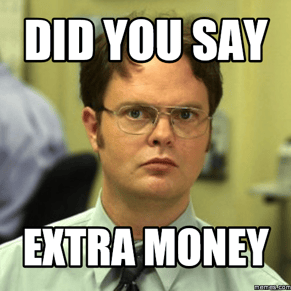
Reducing unnecessary manual steps, file exchange, and countless corrections to the content or the software code and so on, will eliminate additional costs and increase your revenue.
International SEO requires you to do proper research with your team or teams and decide on which countries or regions to target. When planning your international expansion through translation, there are a few relevant steps you need to take:
Check your website traffic data, research statistics on the Internet, or ask your translation agency for advice on which countries to target. If you choose the wrong countries, you will end up with rising costs without an actual return on investment.
It’s crucial that you choose the right language or its version, i.e Brazillian Portuguese vs. European Portuguese, different types of French, and so on.
In order to best reach your chosen audience, you have to speak their language without guessing if this is indeed the right one.
This is also an area where actual experience is crucial. You can’t rely only on statistics and downloadable forms. Translation experts will be able to shed light on the countries that are worth entering and the specific nuances to the language.
You don’t want to miss your business growth opportunity just because you used the wrong version of French, right?
We frequently receive questions like:
What is the best <language> version to use?
We’re looking to determine what languages would make sense as the first ones for translation. Do you have data on that?
And do you want to know why we love those questions? Not because we can share our knowledge and experience, (yes, that too, of course) but because this shows that our clients are really focused on correctly delivering content to the right country/region in the right language.
If you know which language to speak to your prospective customers, there’s no chance that you will do it wrong.
Related content: 15 Languages for Translation That You Should Know About
Before you start the translation and localization process, whether it’s website localization, your product information translation, or marketing translation, you need to make sure you have the keywords covered.
The keywords are the key part of International SEO research. They are not and should not be treated as word-for-word translations of the target keywords in your native language.
Online customer behavior differs from country to country, which means choosing different keywords.
Make sure you do proper keyword research in the language that you are targeting. This is something that an experienced marketing translation agency should be able to help you with.
There are, of course, more aspects of International SEO that are important to remember when entering new markets. From the perspective of a translation company, the three mentioned are the core ones you need to pay attention to.
It’s crucial to know which tools to use to do your research on keywords in other languages and this List of 40+ Tools to Advance Your International SEO Process by Moz may help you spend only as much time and money as necessary.
After making sure that your content creation, product/software, or website development process includes a plan for localization (researching countries, languages, and keywords), it’s time for some more, wait for it: planning.
Planning on how to make the localization process as smooth as possible includes specific aspects.
It’s good to know about what file formats are best for translation so that your localization company doesn’t have to send your data back to you with a nice email while thinking:

And not only because you want to make your translators happy (that too, of course). Most importantly it’s to save your time and your money.
If you send your data in the right file format the first time, the translation costs can be estimated right away, and you can make a decision faster. Your translation, assuming you move forward, can also start right away.
This means you make money as you planned because your product rolls out on time. It means your website reaches a global audience in time for them to start their process buying what you are trying to sell.
Delays are the enemy of business growth.
Don’t make your translation company resend your files asking you politely for the right file formats. Don’t make your customers wait longer for your awesome product, website, marketing content, product manual, or an eLearning platform.
Consistency. It’s one of those hated words when you were in school, but is one of the most important ones when it comes to business growth.
When you create any content that is related to your brand, products, etc. there are certain rules of conduct and content style guides, right?
Without them, your brand would convey its message in multiple voices and tones. The messages would vary depending on who creates them, what mood they are in, and whether they prefer Ozark’s bloody business or Fast and Furious approach to business.
Your brand would become an orchestra confusing your customers instead of being just one clear voice saying: Come to us, we have cookies.
The same applies to translation. If your international content is inconsistent, you risk confusing your customers.
When you partner up with a translation company, make sure you have at least some sort of style guide. In an ideal world, you’d have a glossary of words and phrases that you often use.
Not because the translators are lazy people. Just the opposite, with the complexity of languages, they want to use creativity to reach your audience and the word choice possibilities are endless.
And you need your content to reflect your mission, vision, voice, and tone. You want customers to think: they always deliver exactly what they say and how they say it. Your terminology matters. A lot, actually.
It is important for the translators, reviewers, and any language professionals that translate your content to be sure which terms to use so that your brand is consistent, stable and your customers always associate you correctly.
If you don’t have a glossary and you don’t think it’s necessary, make sure you list any important additional information that your translation agency should know.
Any information that you feel is important, will be important to your translation services company. It’s not war.
Both you and them, have the same goal: for you to take the lead in many markets.
Yes, I mean the actual rates you’ll pay for a translation agency.
Translation rates are easy to learn and compare. The factors that influence the price you’ll pay are:
You’ve got many options and can choose between the cheapest ones to the most expensive ones. And if the translation price is the deciding factor remember that it is important to save as much as possible but not at all costs (pun intended).
Localization will cost money, accept it. How much it costs you will completely depend. Making the right decision on which translation company to choose is one of the biggest factors that answer the question of how much will it really cost me?
When we buy the cheapest products, that usually comes with some risks. Have you ever bought a cheap product that broke after the first use? Sometimes even before you get a chance to use them.
When you go for the cheapest translation services (freelancers or internal resources) you risk so much more than just a $3 hairdryer burning your hand. You risk burning your business to the ground.
There are certain questions that you need to ask before you choose the translation company that is truly the best fit for you.
These are questions like:
And there are more things that you should ask. Here are at least 13 questions that you should ask before you choose a translation agency for your company.
You probably need as smooth processes as possible, in any aspect of your business.
Translation and localization companies can smooth things up for their clients through the direct integration of TMS (Translation Management System) with your system, be it Bitbucket, WooCommerce, WordPress, Zendesk, Adobe Experience Manager, Magento, HubSpot or any other.
Related content: 50+ Translation Integrations You Should Know About
If your system is not integrated with your translation company’s TMS you risk increasing the cost of the localization process.
When going for traditional localization process with emails sent back and forth, endless manual tasks and file exchanges that take forever, you will end up with:
Investing in Translation Platform and in a translation company that is integrated with your system will pay off more than it costs. Do you want to bet?
It is crucial for the content to be reviewed or tested (depending on the content type) after being translated and before being released.
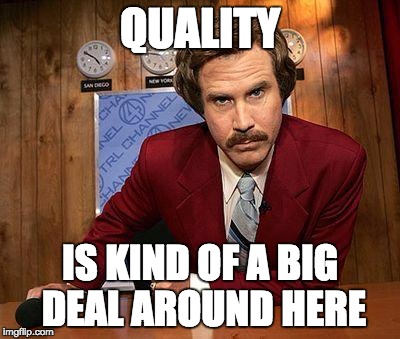
Every translation agency worth their salt delivers both translation and a revision of the translated content.
If you have a possibility of having an in-country review, do it. That way, you will be confident that your content, product software, platform, or application really is in the right language, dialect, and style that you require.
There are just some important facts to remember when it comes to using in-country reviewers.
If you don’t have that option, don’t give up on translation QA checks altogether. Use what you have and use your translation company’s resources.
The QA checks by your translation agency will cost you additionally (usually a one-time fee), but it will cost you more if you skip this part.
Don’t risk offending or angering your customers just because you rely on professionals without verifying with actual in-country expertise.
Now that we’ve covered what it is you are paying for, let’s have a look at some numbers and real-life examples for more clarity.
First, let’s go through the whole translation process. What happens at each stage, what is included in the price, and what is not.
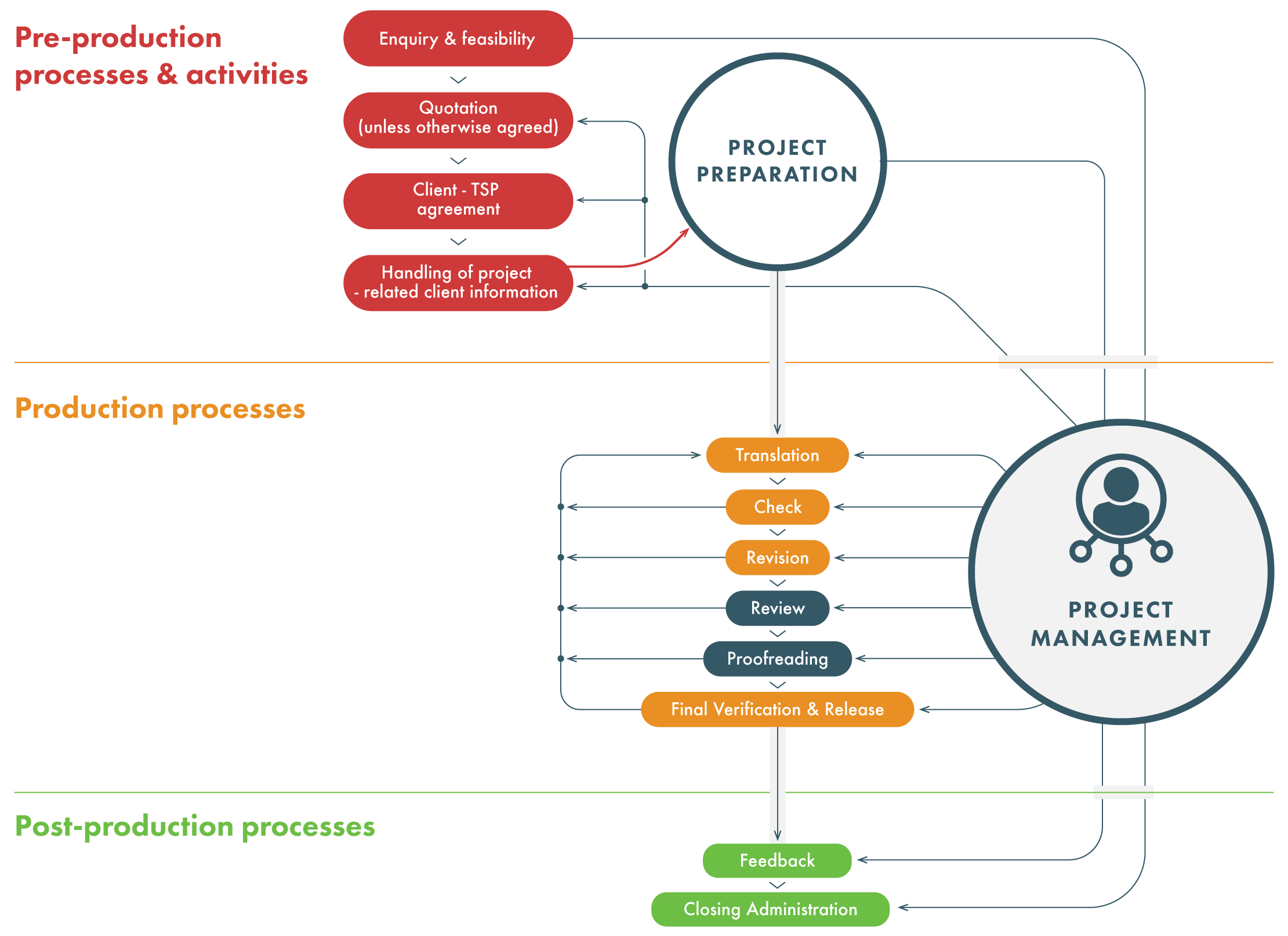
The conversation begins with understanding what clients want to translate. This allows a translation company to establish what you want to achieve through translation and whether they have the resources to do it.
This is the moment when it’s also determined if both parties are a good fit for each other.
At this stage, the translation agency will also determine whether the files that you have at your disposal are something that can be worked with. You’ll discuss the best file formats to send to ensure a smooth translation process.
The options should indicate to clients what file formats will need converting, which could impact the delivery time.
Based on the initial discussion, what you need, what you want to achieve, and what languages you need, a translation company will be able to prepare a quote. You’ll also get an estimate of the time needed to prepare the translation.
At this stage, if you have previously translated content with us, we present estimates of how much money will be saved.
There is a detailed example of how it works in practice later on in the article.
This is the time of deadline negotiations, discussing the process (what steps are needed), NDAs, etc.
This stage is also an important one because it’s where it’s established if and how the client plans to review the translated content, whether they have any preferences, style guides, etc.
At this stage a translation team makes sure all the relevant information regarding your company, your mission and vision statement, the message you want to convey is covered.
It's also the moment where the relevant information about content itself must be disclosed and discussed to avoid any future information gaps that could lead to delays.
This is pretty self-explanatory. At this stage, the translation company transfers content into another language. Translation, of course, is included in the price and it is usually a per-word rate.
This is a self-check done by the translator prior to the delivery of the translated content. This doesn’t require any additional fees.
Editing of the translation by a native speaker in the target language who also checks the text against the source content. It is included in the price, as you will see in the actual examples of real translation + revision price quotes later on.
Monolingual check of the content in a target language when it comes to suitability - to eliminate potential risks of offending or misleading the audience.
It’s optional, not included in the price list per word rate so if a client orders it, they will have to pay for it additionally and this can be either a per-word or an hourly rate. This depends on what the client and the translation agency agree on.
Examination of the revised target language content and applying corrections before printing. This is optional and paid additionally with the conditions as in the Review service.
Verification means a pre-delivery check by a project manager who confirms that the specifications have been fulfilled.
This is when you as a client give your honest and detailed feedback.
This is simply time for invoices and payments.
Now you have a complete overview of what the translation process looks like from A to Z and what is and isn’t included in the price.
What can be less clear (although you can see it on the chart) and is just as relevant, is that the value included in the price is also project management and vendor management.
The checks and full control over the whole process are in the capable hands of project managers. They are the ones that handle the quality checks, keeping the process in line and smooth to deliver the translation on time.
The linguists working on your content translation are always fully vetted and prepared by the vendor managers who verify their expertise in the languages requested and the subject matter.
This also means you’re also freeing your team from extra duties (translation-related) that are probably not what they were trained and hired to do in the first place.
This also means you don’t have to hire additional resources or create a separate localization management team to deal with translation-related tasks. All this is included in the localization costs and should not be forgotten.
To spread even more optimism into the costs’ aspect, take a look at the video explaining shortly how you can save depending on how much you translate.
If you translate your content with one translation company, the translations are stored in Translation Memory. This means that any next translation you send over is analyzed by the CAT tool to detect repetitive phrases.
When you don’t have to translate the same words and phrases, you see cost savings.
Let’s talk details now. Take a look at a real-life example of a quote for a hefty brochures translation project for a client of ours while back. This was a first-time partnership.

Above you can see three figures:
This amount is broken down into two more:
The amount of savings is not that great when compared to the total amount to pay.
Why?
Because they didn’t have many previous translations done.
The next images show you in detail the price of translation + revision service and where the savings actually come from.
In this case, the savings came from the elements of content that were repeated throughout the source content.
The matches always come from the Translation Memory, and since these clients had never had a translation done, the Translation Memory had nothing to show.
As you will see, for each repetition they had to pay only 25% of the actual rate. If they had any type of matches in the content due to previous translations, the clients would pay only a certain percentage of the actual rate.
Usually, it’s from 0-25% for 100% matches (meaning it’s the exact same phrase or wording, 50% for 99 - 84% matches (very close to what has been previously translated), depending on the language.
Important note: these images show the breakdown for each language that the client requested, hence some differences in the price, as depending on the language pair, the rates may differ.
Why?
Because translation companies have to pay their resources who are native speakers of a given language and living in a given country and living expenses in each country differ as you know.
Additionally, the availability of linguists for specific language pairings is a factor too. Some are quite rare so the service costs more and e.g. Chinese has a lot of translators available so the rates are lower.
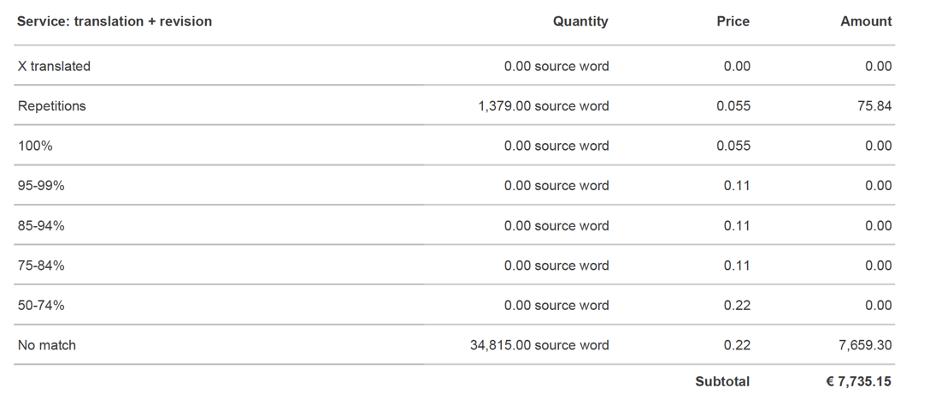
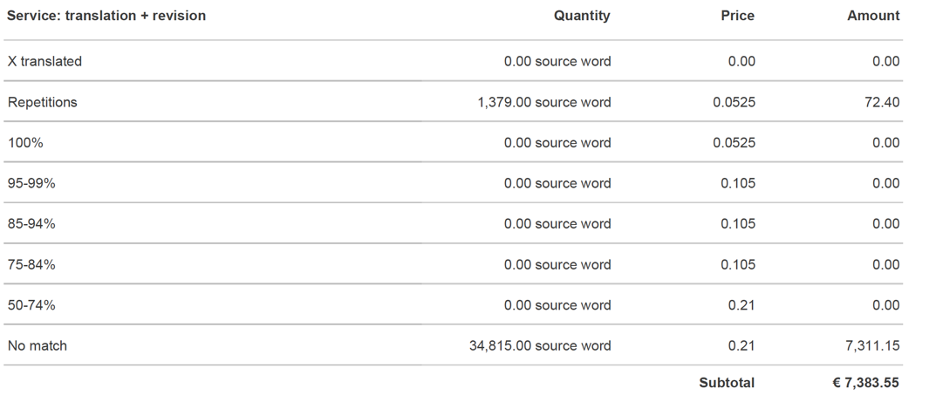 The last image shows that this client also requested additional service, which is not included in the translation+revision rate. In this case, it was Desktop Publishing Service which has an hourly rate.
The last image shows that this client also requested additional service, which is not included in the translation+revision rate. In this case, it was Desktop Publishing Service which has an hourly rate.

As you can see in the example above, the client had to pay a substantial amount of money for translation into two languages and had almost no savings because there were no previous translations.
Should they order next translations, the quote would show a significant increase in the savings amount, due to the previous translations already stored in the system.
You will see it in action in the next example. Can you see the difference in the savings vs. costs?

The savings amount is higher than in the previous example. But take a good look at the images below. The savings are not coming from repetitions only, but there are also different types of matches detected by the translation software.
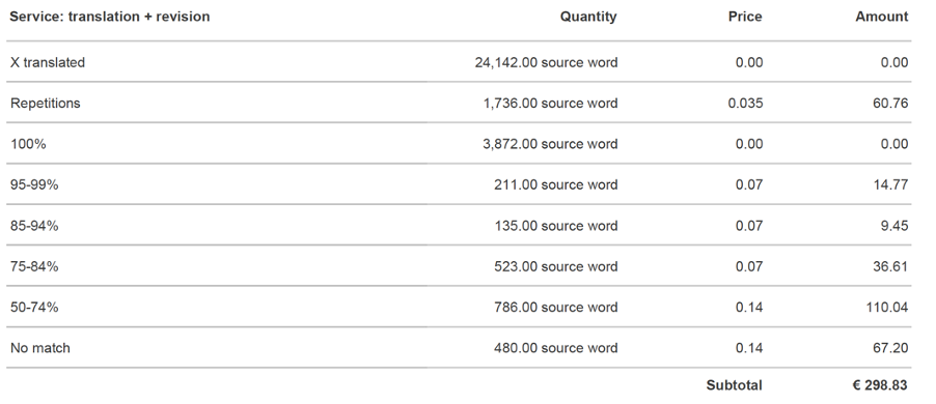
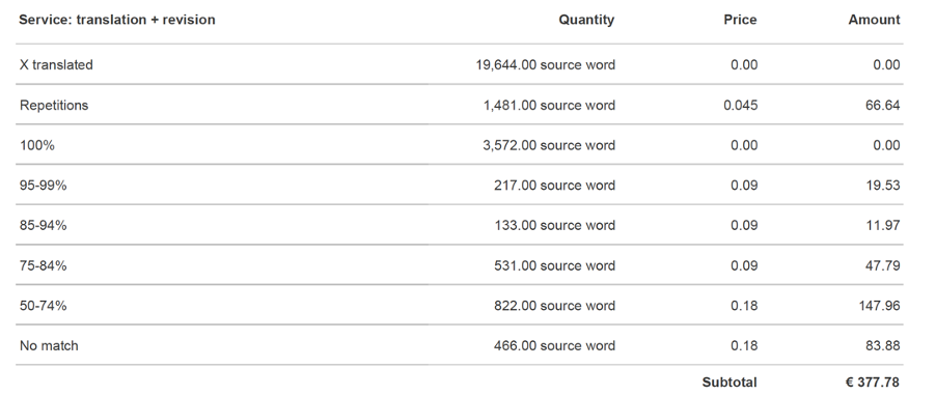
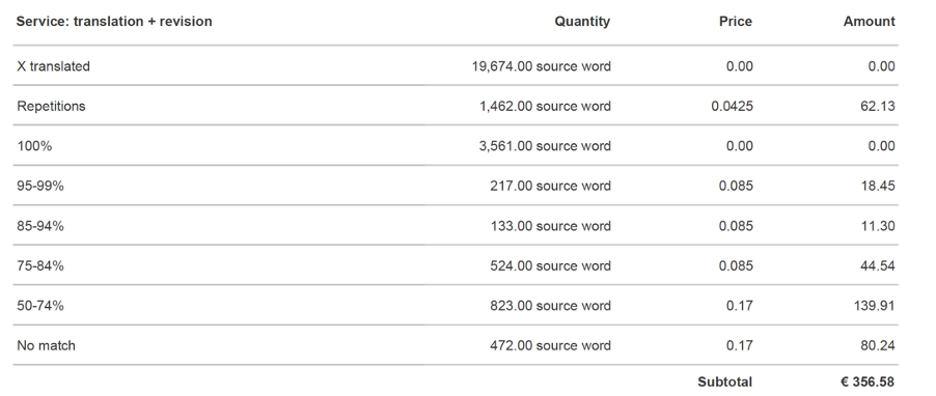
Here we had translation and revision in three languages and the prices here also slightly differ.
These images clearly show how the translation services costs are calculated in terms of the actual price that the clients would pay when ordering a translation and revision service.
They also show the savings, which are generated in an automated way, giving the clients the full scope of how much they pay vs. how much they save.
Another important note: when you send a file for translation, let’s say that they are files containing content that you have on your main web page. Your files contain 50,000 words.
It does not mean that you will pay for the translation of those 50,000 words. As you can see in the images above, the translation software examines the files and categorizes the elements for translation called segments into repetitions, different types of matches, and no matches.
So the actual number of words for translation called a number of weighted words will be different from your 50,000 words. It will be less.
It depends on:
It might be useful to take a look at Common Sense Advisory’s report on translation pricing by language pair that is a foundation for how translation companies calculate their own price lists.
It also shows a price range that you can expect when you consider working with a translation agency.
The important note to remember is that when you do translation right you make money.
Unless you send the actual file for translation and it’s examined by the translation software it’s even difficult to suggest how much you will pay.
You can check the rates per word, but without knowing how many weighted words there are in the content, you will not be able to calculate the price.
Localization costs are not easy to describe. The translation is not a book, a lipstick, or a tie that you can get a clear price for then and there.
It’s more like a car where depending on the options you choose, you’ll end up with a different price.
And if you decide to go for more complex and better solutions it will make your rides fast. Without the fury. Yes, I mean a faster and more efficient translation process that will cost you more but will deliver better results.
If you decide to dial down on the investment you will still get to your destination. You will get your translation done. It may just take a little longer.
Recommended articles:
A Simple Way to Save on Your International Communication
What to Look for in the Translation Rates
How to Accelerate a New Product Launch Globally [e-book]
+1 857 777 5741 ext. 203 (business inquiries)
+1 857 777 5741 ext. 205 (career inquiries)
Trylinskiego 16, 10-683
Olsztyn, Poland
Copyright ATL 2025. All Rights Reserved.